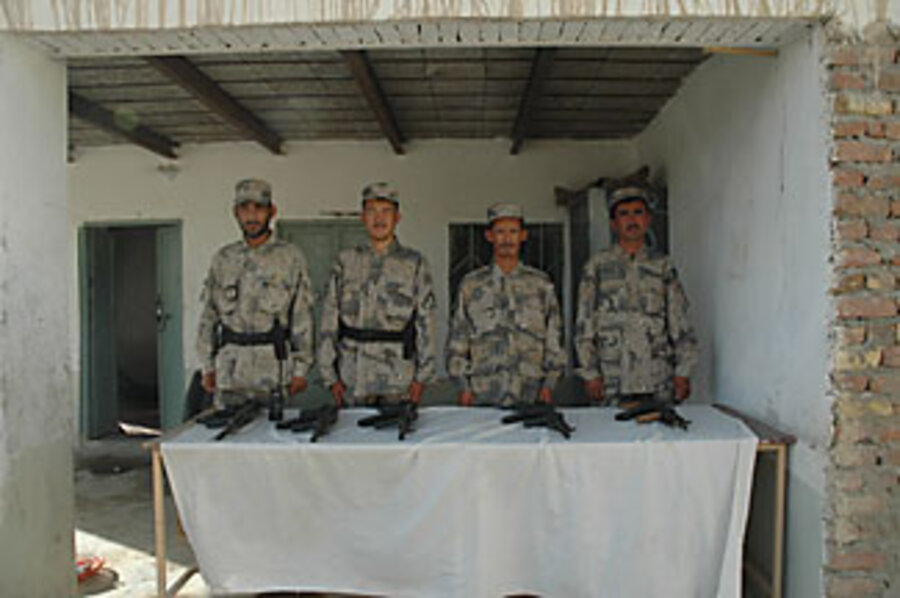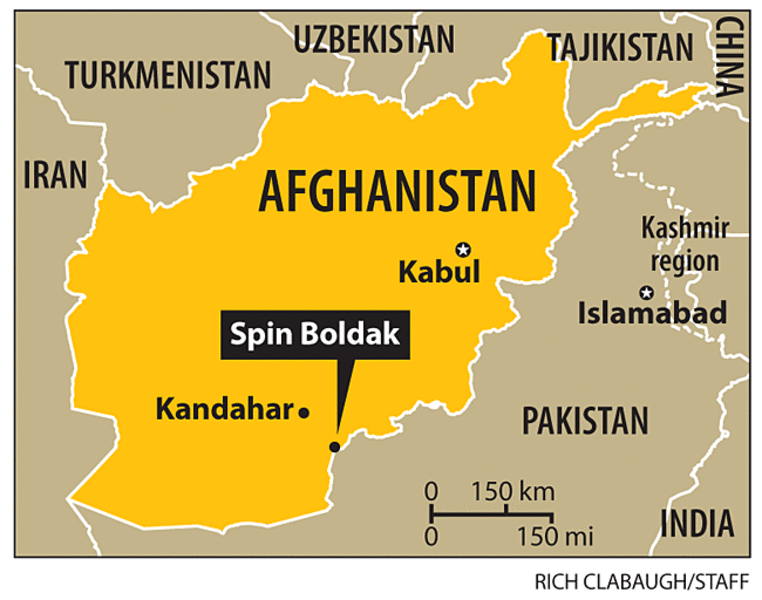Afghans fight flow of drugs and guns fueling Taliban insurgency
| Spin Boldak, Afghanistan
In Southern Afghanistan, long ground zero in the battle against the Taliban, Western forces are adjusting their tactics by turning fresh attention to the region's border with Pakistan.
Every day, more than 25,000 people cross an 800-mile boundary skirting Kandahar, Helmand, Nimruz, and Zabul Provinces. Some of these commuters feed the insurgency by smuggling weapons and Taliban fighters into Afghanistan, or by bringing out drugs that fund the rebels' activities.
Now, the United States is trying to build up the region's border police responsible for stopping the trafficking – a force still in its professional infancy.
So far, only a fraction of Afghan Border Police (ABP) officers here have been formally trained, with many more units set to complete the program in the coming months.
The American commanders overseeing the program acknowledge that corrupt and unprofessional behavior among border guards in the south is widespread, but insist that with more resources, training, and time, things will improve.
Last month, 200 ABP officers graduated from the six-week training program – the second group in the south to complete this training, out of a total of about 3,200 ABP officers.
A US Army spokesman says that they hope to bring the number of ABP on the southern border to just over 4,400 men.
Keeping the bombs out
Though the agency has a long way to go before reaching that goal – and becoming corruption-free – the training has started to yield results.
The first group to graduate from the program recently stopped two trucks attempting to cross into Afghanistan that were loaded with detonation wires and blasting caps, two main ingredients in the improvised explosive devices (IEDs) that insurgents commonly use to target Western forces.
According to the Afghan police official in charge of that investigation, the trucks' occupants were arrested and the vehicles seized, though the company's owners were not charged.
Many border police are recruited from the regular Afghan National Police, but it's hard to attract the best training officers due to a pay differential: Border police trainers earn less than their district police counterparts, though the officers in the field make equivalent salaries. The work is also arguably more dangerous than district policing.
"These guys are out in the middle of nowhere in small teams," says US Army Col. Bill Hix, who commands coalition troops responsible for training Afghan security forces in southern Afghanistan.
Brig. Gen. Saifullah Hakim, who oversees the southern ABP program from a base in Spin Boldak, near Kandahar, says that one consequence of the added danger and pay differential is that much of his force is poorly educated, even illiterate.
"If you tell them something 101 times," says General Hakim of his men, "maybe the 101st time, they will learn it."
Belated focus on southern border
US and Afghan security officials say that in Afghanistan's eastern provinces, border police training has been going on for much longer.
"We've only been focusing on the border police in the south for nine months," says Hix. Until now, the focus in Afghanistan's violent south has been on building the region's district police forces, and "there just weren't enough resources to train the border police," he explains.
It took longer to begin training programs for border patrol officers in the south, because the fight here is viewed by US military commanders as less of a commuter's war. Kandahar is the birthplace of the Taliban movement, and, unlike the northern and eastern regions of Afghanistan, homegrown insurgents are plentiful.
"In the east, they have a much bigger Pakistan problem than we do," says Hix, referring to Pakistan's tribal areas across the border. where militants enjoy safe haven and can enter Afghanistan freely. "Down here, a lot of the enemy is local. In the south, the enemy is enabled by forces in Pakistan, not dependent on Pakistan."
As for corruption, he says that "there will always be smuggling. Always has been, always will be, as there is in every country in the world. But coalition monitors tell me that pilferage here is less than the percentage of pilferage that has been documented at some Western ports of entry."
Hundreds of miles to stop up
Afghan security officials understand all too well the problems facing the ABP.
"I believe in the border police's efforts, and I believe they're capable," says Brig. Gen. Shermohammed Zazi, who commands the Afghan National Army's 205 Corps in Kandahar. "But they don't have enough personnel to cover a 1,000-plus kilometer border, and they don't have proper equipment."
And of course, the border has two sides. Some ABP officials complain that their Pakistani counterparts, though better funded, are less effective than the Afghans are.
Still, resources for the border police on the Afghan side are what most concern coalition forces here.
In southern Afghanistan, district-level police number between 6,000 and 7,000, about twice the size of the border patrol. Money for the ABP comes out of the larger police budget, making it difficult to gauge the exact cost of the program. Hix has promised to provide Hakim with up-armored Humvees and other equipment once it becomes available.
The six-week training currently offered by the coalition is less about police work and more about how to survive contact with insurgents. Unlike district police, the border guards operate in small units on far-flung outposts, with little backup.
It's a dangerous job, and the training includes an emergency medical care component to help stem casualties.
While Afghan and US security officials are optimistic about the program, the ABP has a long way to go.
"Here," says Hix, "hope is in degrees."






